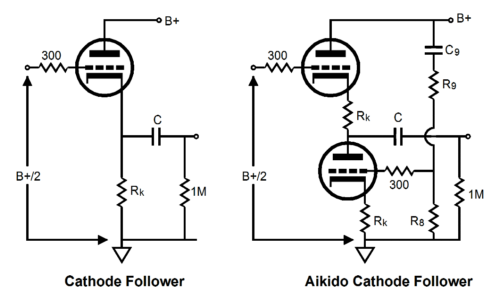


V2 is connected as a cathode follower because of the unusual high value of R5 it has full current feedback and therefore no amplification, no distortion and hardly any grid/plate capacitance. C10 and R26 play an important role in controlling the supersonic characteristics and are discussed in chapter 10. On the plate side of the tube there is the direct connection to the grid of V2 which dictates the tensions and currents of the latter. R4 is not partially decoupled by a capacitor like in other amps and enjoys a lot of current feedback through R4 and as a result not much amplification (approx 10 to12X without the feedback loop) but very low distortion. On many amps an suppresser resistor is connected between R1 and the grid of V1a to avoid instability (Typical value 10K) when however stability is not a problem such a suppresser should be avoided. The absence of an input capacitor means that the input signal must have no dc component. The easy to obtain 12AU7 (ECC82) and 6SN7 do the job just as good as the 6J5 when the plate current is adjusted by doubling the value of R4. The input stage looks simple but was fairly new when presented by Williamson. Determining the value of R25 will be discussed in chapter 10. The exact input sensitivity depends on the amount of negative feedback (Williamson prescribes 20 db (or 10 fold) but depends also on the amplification factor of the tubes that are used in this design. Note that these values are ideal for digital equipment. R25 connects the loudspeaker output to the input stage for negative feedback which reduces distortion, increases the frequency range, and decreases the input sensitivity to a value of 1 to 2 volt for full power output. If you choose values like 1 mf low frequency oscillation may occur, at 0.5 Hz to1Hz (you won't hear it but may bring clipping closer). 220nf for the capacitors between the stages is big enough for the lowest notes. The capacitors between the stages should be also be high quality 630volt mkp types. bypass all electrolytic capacitors by high quality 220nf mkp capacitors (630volt) for better sound. Choose for all electrolytical capacitors values like 50 or 100 mfd 450 volt operating tension (550 volt peak) and replace L1 in this diagram by a 1K resistor. Chokes, on the contrary, were common and cheap. In chapter 9 we will go into the power supply design.Īt the time this amplifier was designed electrolytic capacitors with values like 50 or 100 mfd were very expensive and rare. The tension from the power supply on the centre tap of the output tranformer should be around 445 volt. In those versions the values of R4 and R10 should be doubled for the right bias of the tubes. In later versions the four 6J5' s were replaced by two 6SN7 's (double triodes). The tubes used were V1-V4 6J5 V5 and V6 KT 66. In tthe first version C10 and R26 were not present (in chapter 10 we will go into the C10 and R26 questions). Above the circuit as it was published in the revised version in 1949., without the power supply.


 0 kommentar(er)
0 kommentar(er)
